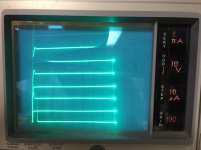I know, aren't these updates *exciting*!? I'll bet you're falling off the edge of your chair just waiting for the next one!
Aside... There might be more ways to improve it, make it more versatile and add features. For now I'm pleased with the symmetrical aspect... I'd be happy to receive requests or complaints.
- keantoken
Aside... There might be more ways to improve it, make it more versatile and add features. For now I'm pleased with the symmetrical aspect... I'd be happy to receive requests or complaints.
- keantoken
Sorry to butt in late, I did some rudimentary physical tests and lots of theoretical tests and it seems the way Vce modifies hFE is portrayed in some datasheets and models is not correct, actually it is so bad it defies belief. There was another thread where I posted the Spice and real results.
PS: found it:
http://www.diyaudio.com/forums/software-tools/158209-spice-transistors-2.html
PS: found it:
http://www.diyaudio.com/forums/software-tools/158209-spice-transistors-2.html
Last edited:
Curve tracer data and data sheet do not always agree
I'm trying to find a way to model the effects seen in the photo attached. This is an Onsemi PZTA42. Note that there is a "current spike" when V_ce is approximately 4-5V. I asked our OnSemi tech support team to compare, and very similar results were obtained at the factory. Many other devices show this same effect, both NPN and PNP.
I think this is a physical effect based on the way the die is constructed, but I am not sure.
Since I bought a curve tracer (Tek 576), I have found many data sheet curves to be inaccurate. This is particularly important if you are trying to build an amplifier with limited or no feedback.
I'm trying to find a way to model the effects seen in the photo attached. This is an Onsemi PZTA42. Note that there is a "current spike" when V_ce is approximately 4-5V. I asked our OnSemi tech support team to compare, and very similar results were obtained at the factory. Many other devices show this same effect, both NPN and PNP.
I think this is a physical effect based on the way the die is constructed, but I am not sure.
Since I bought a curve tracer (Tek 576), I have found many data sheet curves to be inaccurate. This is particularly important if you are trying to build an amplifier with limited or no feedback.
Attachments
Looks curious! Perhaps it is caused by the special high-voltage transistor construction.
But can you double check it by playing around with the rate and/or step parameter in the right bottom corner of the Tek 576. And how is the curve if you go with Vce only to a lower range?
But can you double check it by playing around with the rate and/or step parameter in the right bottom corner of the Tek 576. And how is the curve if you go with Vce only to a lower range?
- Status
- Not open for further replies.
